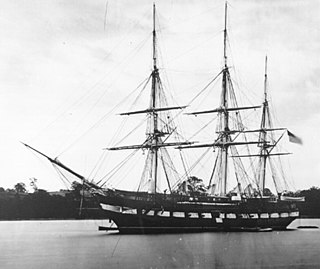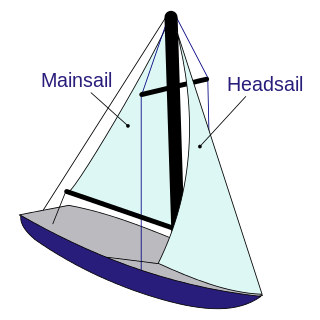
Mystic is a village and census-designated place (CDP) in Groton and Stonington, Connecticut; it has no independent government because it is not a municipality in the state of Connecticut.

A yawl is a two-masted sailing craft whose mainmast is taller than the mizzen mast. Compared to a similar sized ketch, a yawl's mizzen mast is set further aft and its mizzen sail is smaller.

A brig is a sailing vessel with two square-rigged masts. During the Age of Sail, brigs were seen as fast and maneuverable and were used as both naval warships and merchant vessels. They were especially popular in the 18th and early 19th centuries. Brigs fell out of use with the arrival of the steam ship because they required a relatively large crew for their small size and were difficult to sail into the wind. Their rigging differs from that of a brigantine which has a gaff-rigged mainsail, while a brig has a square mainsail with an additional gaff-rigged spanker behind the mainsail.

A barque, barc, or bark is a type of sailing vessel with three or more masts having the fore- and mainmasts rigged square and only the mizzen rigged fore-and-aft.

The Bermuda sloop is a type of fore-and-aft rigged single-masted sailing vessel developed on the islands of Bermuda in the 17th century. Such vessels originally had gaff rigs with quadrilateral sails, but evolved to use the Bermuda rig with triangular sails. Although the Bermuda sloop is often described as a development of the narrower-beamed Jamaica sloop, which dates from the 1670s, the high, raked masts and triangular sails of the Bermuda rig are rooted in a tradition of Bermudian boat design dating from the earliest decades of the 17th century. It is distinguished from other vessels with the triangular Bermuda rig, which may have multiple masts or may not have evolved in hull form from the traditional designs.

In the 18th century and most of the 19th, a sloop-of-war in the Royal Navy was a warship with a single gun deck that carried up to eighteen guns. The rating system covered all vessels with 20 guns and above; thus, the term sloop-of-war encompassed all the unrated combat vessels, including the very small gun-brigs and cutters. In technical terms, even the more specialised bomb vessels and fireships were classed as sloops-of-war, and in practice these were employed in the sloop role when not carrying out their specialized functions.

A cutter is generally a small to medium-sized vessel, depending on its role and definition. Historically, it was a smallish single- or double-masted, decked sailcraft designed for speed rather than capacity. As such, it was gaff-rigged, with two or more headsails and often a bowsprit of some length, with a mast sometimes set farther back than on a sloop. While historically a workboat, as used by harbor pilots, the military, and privateers, sailing cutters today are most commonly fore-and-aft rigged private yachts.

Joseph Conrad is an iron-hulled sailing ship, originally launched as Georg Stage in 1882 and used to train sailors in Denmark. After sailing around the world as a private yacht in 1934 she served as a training ship in the United States, and is now a museum ship at Mystic Seaport in Connecticut.

Charles W. Morgan is an American whaling ship built in 1841 whose active service period was during the 19th and early 20th centuries. Ships of this type were usually used to harvest the blubber of whales for whale oil, which was commonly used in lamps. Charles W. Morgan has served as a museum ship since the 1940s and is now an exhibit at the Mystic Seaport museum in Mystic, Connecticut. She is the world's oldest surviving merchant vessel and the only surviving wooden whaling ship from the 19th century American merchant fleet. She was designated a National Historic Landmark in 1966.
Philip Leonard Rhodes (1895–1974) was a naval architect known for his diverse yacht designs. He designed a wide variety of vessels from 123' motor-sailors to 7' dinghies, from hydrofoil racers to giant motor yachts. His work also included commercial and military vessels such as minesweepers and police boats. His clients ranged from Rockefellers to Sears & Roebuck. His 12 Meter class Weatherly (USA-17) won the America's Cup in 1962.

Lettie G. Howard, formerly Mystic C and Caviare, is a wooden Fredonia schooner built in 1893 in Essex, Massachusetts, USA. This type of craft was commonly used by American offshore fishermen, and is believed to be the last surviving example of its type. She was declared a National Historic Landmark in 1989. She is now based at the South Street Seaport Museum in New York City.

L. A. Dunton is a National Historic Landmark fishing schooner and museum exhibit located at the Mystic Seaport Museum in Mystic, Connecticut. Built in 1921, she is the last ship afloat of her type, which was once the most common sail-powered fishing vessel sailing from New England ports. In service in New England waters until the 1930s and Newfoundland into the 1950s. After a brief period as a cargo ship, she was acquired by the museum and restored to her original condition.

Emma C. Berry is a fishing sloop located at the Mystic Seaport Museum in Mystic, Connecticut, United States, and one of the oldest surviving commercial vessels in America. She is the last known surviving American well smack. This type of boat is also termed a sloop smack or Noank smack. Emma C. Berry was built in 1866 at the Palmer Shipyards in Noank, Connecticut by James A. Latham. Well smacks were designed to keep the catch alive in an internal water-filled compartment known as a wet well. Seawater circulated through large holes in the bottom planking. The Noank design was imitated in other regions of the United States, but well smacks had appeared in England previously in about 1775.

The Cruizer class was an 18-gun class of brig-sloops of the Royal Navy. Brig-sloops were the same as ship-sloops except for their rigging. A ship-sloop was rigged with three masts whereas a brig-sloop was rigged as a brig with only a fore mast and a main mast.

Regina M. is a Carry Away Sloop located at Mystic Seaport in Mystic, Connecticut, United States. Regina M. was built in 1900 in Passamaquoddy Bay and was used to collect herring from fish weirs and transport them to canneries on shore. Mystic Seaport acquired the vessel in 1940 to add to their collection of watercraft. In 1992 Regina M. was restored to the way she looked in 1909.

John Faunce Leavitt (1905–1974) was a well-known shipbuilder, writer on maritime subjects, painter of marine canvases, and curator of Mystic Seaport in Mystic, Connecticut.

Hope is an oyster sloop that was completed in 1948. It is believed to be the last sail-powered oystering vessel built on the Long Island Sound. Hope is 56 feet (17 m) long, including the bowsprit, and 42 feet 2 inches (12.9 m) at the waterline. Its beam is 15 feet 2 inches (4.6 m), and it draws 4 feet 9 inches (1.4 m) with the centerboard up. Hope is gaff rigged, 'V'-bottomed and has an 850-pound (390 kg) centerboard. Hope's shallow draft facilitated shoal water work.





















